Krupp Diamond/Elizabeth Taylor Diamond
Open FREE Unlimited Store Join Our Newsletter
Origin of name
The Krupp diamond gets its name from actress Vera Krupp von Bohlen und Halbach, the original owner of the diamond, and second wife of Alfried Krupp von Bohlen und Halbach , who belonged to the famous Krupp family, owners of Krupp AG, the industrial giant of Germany, that was one of the world's principal steel makers and arms manufacturers until the end of World War II. Established in 1811 by Friedrich Krupp, the company was the first to introduce the Bessemer and the Open-Hearth steel making processes on the European Continent. The company became internationally famous during world war I, by manufacturing guns, such as the 16.5 inch (420mm) howitzer called the "Big Bertha" and the long range gun that in the spring of 1918 bombarded Paris from a distance of about 75 miles (120 Km). During the second world war Adolf Hitler, used the company to produce military hardware needed for his military conquests. The Krupp Combine manufactured submarines, trucks, locomotives, and warships, in addition to artillery and munitions. After world war II, at the Nuremburg trial, Alfried Krupp von Bohlen und Halbach, the chairman of the company was convicted of war crimes, specifically for the employment of slave labor. The company was re-organized in the 1950s, and eventually became one of the largest companies in West Germany, manufacturing steel, heavy machinery, transportation equipment, automotive parts and assembly and industrial plants.
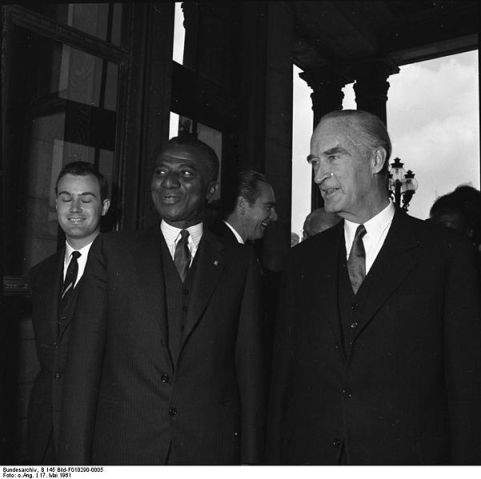 Alfred Krupp with President Sylvanus Olympio of Togo, when the latter visited Villa Hugel the residence of the Krupp family in 1961
Alfred Krupp with President Sylvanus Olympio of Togo, when the latter visited Villa Hugel the residence of the Krupp family in 1961
The Krupp diamond was subsequently involved in a famous jewel heist in Las Vegas in 1959, while still in the possession of Vera Krupp, a mystery that was successfully unravelled by the FBI, the culprits apprehended and prosecuted, and the diamond recovered and retored to its owner. The diamond later changed hands in 1968, after the death of Vera Krupp, when it was sold as part of her estate, at a Sotheby's New York auction on May 16, 1968, and purchased by Richard Burton for $305,000, the highest price paid for a diamond ring at an auction, at that time. Burton gifted the celebrated ring to his beloved wife, Elizabeth Taylor, who was delighted to receive it. The ring became the prized possession of the internationally renowned Hollywood celebrity, who wore it on all occasions, and became closely associated with her identity. Dame Elizabeth Taylor was the "custodian" of the ring, as she preferred to characterize herself with respect to the ownership of her enormous collection of jewels, until her death on March 23, 2011. Thus, the Krupp Diamond became internationally renowned, and joined the list of famous diamonds, for more than one reason. Firstly it was owned by the ex-wife of the proprietor of a leading industrial giant in the world, Krupp AG. Secondly it became famous, because of its involvement in a sensational jewel heist in Las Vegas, a mystery that was successfully solved by the FBI, and finally, the diamond's popularity was further enhanced when it came into the possession of the most celebrated actress in the history of Hollywood, the uncrowned Queen of Hollywood, Dame Elizabeth Taylor.
Characteristics of the diamond
According to the Gemological Institute of America report, the Krupp Diamond/Elizabeth Taylor diamond is a cut-cornered rectangular- cut (asscher-cut), D-color stone, with a weight of approximately 33.19 carats and VS1 clarity mounted on a platinum ring, flanked on either side by a tapered baguette-cut diamond. The GIA has also stated that the clarity of the diamond may be potentially internally flawless, meaning that the clarity could be further improved by slight recutting.
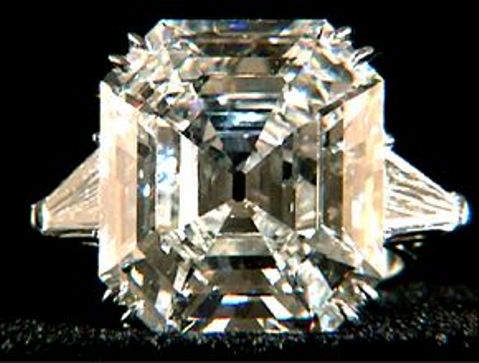
33.19-carat, Asscher-cut, D-color, Krupp Diamond mounted on a ring with two baguette cut diamonds set on the shoulders
A supplementary letter accompanying the report, also states that the diamond has been determined to be a Type IIa diamond, under which D, E and F color diamonds fall. Such diamonds are not only chemically pure but also structurally perfect, and as a result absolutely colorless, constituting about 1-2 % of all naturally occuring diamonds. A tiny percentage of Type IIa diamonds (around 0.1 %) are chemically pure but structurally distorted, which imparts rare fancy colors to these diamonds, such as pink, red, purple and brown.
When a diamond is absolutely colorless, usually an accompanying report is not necessary to confirm that it is Type IIa. However, if a diamond also shows fluorescence producing a slightly bluish tinge in sunlight rich in U-V wave lengths, as the Krupp diamond is reported to have possessed in previous reports, an infra-red spectroscopic analysis becomes necessary to distinguish between Type Ia and Type IIa, as fluorescence can mask any slightly yellow body color found in some Type Ia diamonds. The presence of fluoresence however does not depreciate the value of a diamond, as many famous diamonds indeed show a bluish-tinge caused by fluorescence, such as the Portuguese diamond, Regent diamond, Queen of Holland diamond, Idol's Eye diamond and Jacob-Victoria diamond and some of these diamonds, such as the Regent diamond and Idol's Eye diamond in fact originated in the famous Kollur mines of Southern India, whose diamonds set the standard for comparing diamonds from other sources.
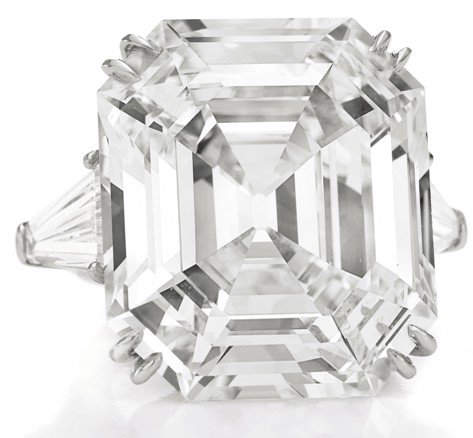
Krupp diamond/Elizabeth Taylor diamond from the Christie's auction catalogue
© Christie's
History
The early history of the diamond
The early history of the diamond, such as the mine of origin, the date of discovery, the weight of the rough stone, the identity of the master cutters involved with its cutting etc. are not known. However, it is well known that Vera Krupp acquired the celebrated diamond ring from Harry Winston Jewelers, probably after relocating to the 520-acre "Spring Mountain Ranch" in Las Vegas in 1957, which she purchased from radio personality Chester Lauck, after an expensive divorce settlement from her husband Alfried Krupp, the owner and head of the Krupp Company. Vera married Alfried Krupp on May 19, 1952, soon after he was released from Landsberg Prison, after serving a three-year prison term, following his conviction on war crime charges, for the use of Jewish slave labor by his company during the war. It is said that Vera Krupp loved the diamond ring, and wore the ring with its massive Asscher-cut diamond, everywhere and on all occasions, unintentionally exposing the diamond and attracting the attention of undesirable elements, including thieves, who became aware of her valuable possession, which at that time was worth a small fortune - around $275,000.
The famous Las Vegas jewel heist of 1959 in which the Krupp Diamond was stolen but successfully recovered by the FBI
The unintentional advertising of her affluence, coupled with the isolated environment in which she lived, a sprawling 520-acre ranch about 26 miles southwest of Las Vegas, was a tempting scenario for any would-be thief to attempt a break-in without being detected. And break-in they did, when three men knocked on her front door, on the evening of April 10, 1959, offering to blacktop the long driveway leading to her ranch house, as Vera Krupp and her foreman were just finishing dinner. In a flash they had forced their way in, and the first thing they did was to rip the diamond ring off Vera's finger, injuring the finger and causing it to bleed. They then blindfolded the two of them, and tied them back to back with wire taken from a lamp. The robbers then did a quick search of the house, and apart from the diamond ring also stole $700,000 in cash, a revolver and a camera. Vera Krupp and her foreman were eventually able to free themselves, and rushed to the Las Vegas airport to alert the authorities, as their battery-powered ranch phone was already dead.
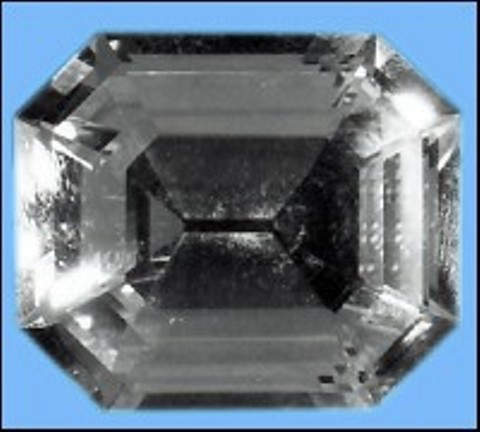
Photograph of Krupp Diamond from the FBI files
The FBI was informed and were quickly on the trail of the thieves, having made the assumption that the diamond would be carried across state lines, before an attempt was made to dispose of it. The attention of the FBI was soon directed towards one John William Hagenson, a fugitive on the run, and wanted for a similar offence in California. Hagenson's zigzag move across the country was tracked by agents based in almost a dozen field offices, and he was eventually arrested in Louisiana. The FBI was soon able to add more names to the list of suspects, and also piece together the movement of the thieves from city to city, as shown in the map below. The trail begins in Las Vegas, Nevada and ends in Newark, New Jersey, after going through at least ten more cities, some on more than one occasion such as Miami Beach and Chicago. Agents of the FBI based in all field offices were also on the alert to see whether the large diamond would end up somewhere for sale.
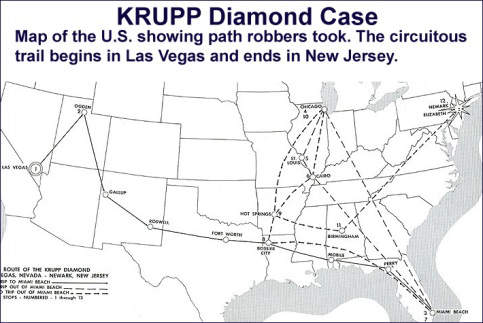
The zigzag route taken by the Krupp diamond thieves
As expected, the diamond did appear about six weeks later, in Newark, New Jersey. An agent based in the city, was alerted by a criminal informant that a local grocer had been looking for prospective customers to sell a big diamond. FBI agents quickly arrested the man, who led them to one of the thieves, James Reves. A thorough search of the thief's hotel room in Elizabeth, led to the discovery of the Krupp diamond, that was stitched into the lining of his coat hanging in a closet. The two baguette diamonds that was part of the setting of the ring, were also recovered from a jeweler in St. Louis during the investigations.
Hagenson, the alleged mastermind of the heist, Reves and other accomplices were prosecuted in November 1959, convicted and given terms of imprisonment for their part in the crime. However, Hagenson was able to escape punishment on appeal. After the trial, Mrs. Vera Krupp was able to rebuild her original ring using the 33.19-carat diamond as the centerpiece on a four-pronged setting, and the two baguette-cut diamonds set on the shoulders of the ring on either side.
The possible period in which the diamond was discovered and cut
The cut employed on the Krupp diamond is the square emerald-cut known as the Asscher-cut, after it was first designed and patented in 1902, by Joseph Asscher who together with his brother Abraham Asscher became successors to the Asscher Diamond Company based in Amsterdam, Netherlands, founded by their grandfather Joseph Isaac Asscher in 1854, and first named I. J. Asscher Diamond Company, named for the founder's son Isaac Joseph Asscher, who was Joseph and Abraham's father. The Krupp diamond also has a fairly large culet facet, a clear indication that the diamond was cut before the 1920s, when the culet facets were being phased out. Thus, the possible period during which the Krupp rough diamond was discovered and subsequently cut employing the Asscher-cut, lies between 1902, the year the Asscher-cut was first introduced and the 1920s, the year the culet facet was eliminated.
Was Jagersfontein mine in South Africa the source of the Krupp diamond?
The Krupp diamond is described as a D-color diamond, also known as top-color diamond. Such diamonds are Type IIa diamonds, and are absolutely colorless. However, such diamonds can sometimes show fluorescence in bright daylight rich in ultra-violet wave lengths, producing a bluish tinge. In fact the Krupp diamond has been described variously as a bluish-white stone, or a white stone with a bluish tinge, obviously caused by fluorescence. Such diamonds with a faint bluish tint known as "jagers" was characteristic of diamonds produced from the Jagersfontein mine of South Africa, an open-pit mine situated 109 km southwest of Bloemfontein, and first established in 1888. Open-pit mining was practised in this mine until 1913, after which underground mining was started and continued until 1971, when the mine was finally closed. Thus, going by the bluish tinge in the diamond, the Krupp diamond most probably originated in the Jagersfontein mine of South Africa, during the period 1902 to 1930.
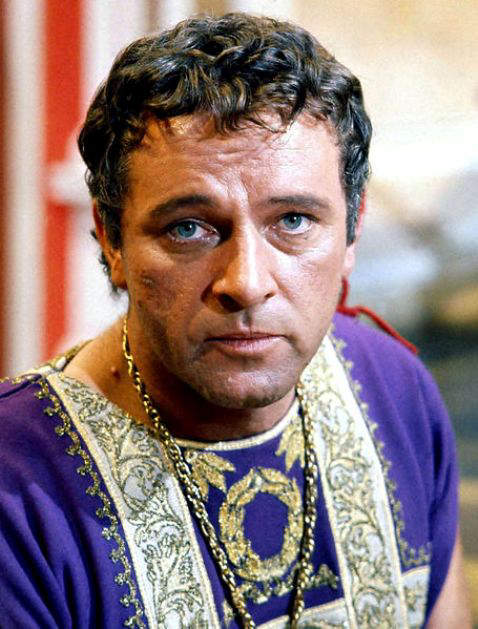
Studio publicity portrait of Richard Burton in the film Cleopatra
Richard Burton's "fire-and-ice" relationship with Elizabeth Taylor
Richard Burton and Elizabeth Taylor will go down in history as the most celebrated couple, who could not live with or without each other. Their relationship has been characterized as a fire-and-ice relationship. The couple were married and divorced twice, the first from March 15, 1964 to June 26, 1974 and the second from October 10, 1975 to July 29, 1976, with a break of 16 months between the two marriages.
It all began on the sets of the blockbuster film Cleopatra in 1961, in which Burton played the role of Julius Caesar, and Taylor that of Cleopatra, the historic episode that was a popular theme for many a Hollywood film. At that time both of them were married to others, Burton to Sybil Williams and Taylor to Eddie Fischer. An intense and passionate relationship developed between them, that was evident to all those who worked on the sets, and inevitably led to the divorce of their spouses, and their eventual marriage in March 1964. The scandal sent shock waves around the world and did not go down well with their fans. However, the intensity of the love between them was an undeniable fact, and the world reconciled to their relationship.
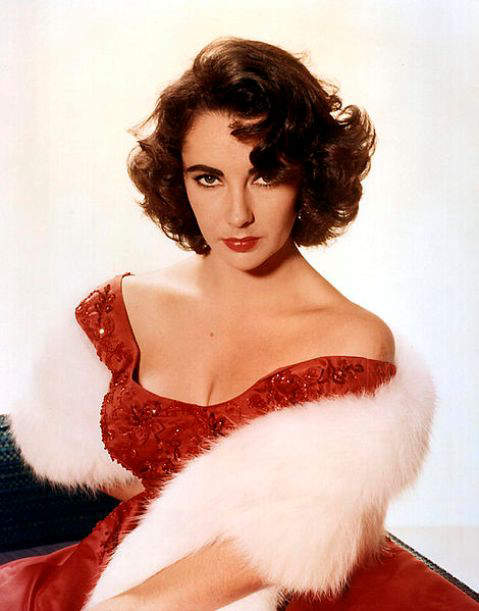
A studio publicity portrait of Elizabeth Taylor
Burton's extravagance and the lavishing of expensive jewels on Taylor during their first marriage that lasted 10 years
Burton was well known for his extravagance, and lavished expensive jewels and jewelry on his beloved wife Liz, through out their relationship, and she was able to build up an impressive collection of these valuables. Burton's attachment to his wife was so intense that at one time he is reported to have said, "I cannot see life without Elizabeth. She is my everything, my breath, my blood, my mind and my imagination."

Emerald and Diamond Pendant Brooch by Bulgari, used by Burton to propose to Taylor
The first item of jewelry she lavished on her was a Bulgari pendant with an 18.61-carat emerald, surrounded by diamonds, and set in platinum, which could also be detached and worn as a brooch. It is with this item of jewelry that Burton proposed to Taylor before their marriage, and was the only item of jewelry, worn as a brooch by Taylor, during their wedding ceremony.
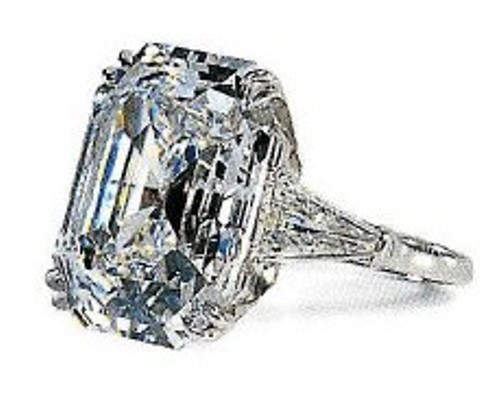 Another view of the famous Krupp Diamond
Another view of the famous Krupp Diamond
The next important item of jewelry he bought for Taylor was the famous, 33.19-carat, asscher-cut Krupp diamond, set in a platinum ring, which is the subject of this narrative. In her book "Elizabeth Taylor-My Love Affair with Jewelry", Taylor says, "the Krupp diamond was owned by Vera Krupp of the famous German munitions family, which helped knock off millions of Jews. When it came up for auction in the late 1960s, I thought how nice it would be if a nice Jewish girl like me were to own it." Taylor converted to Judaism, to marry her fourth husband Eddie Fisher. Taylor developed a strong personal attachment to the Krupp diamond, and wears the ring mounted with it, constantly in her hand up to this day. She was seen wearing it in all the films she starred after 1968 and the diamond came to be closely associated with her identity as an international celebrity.
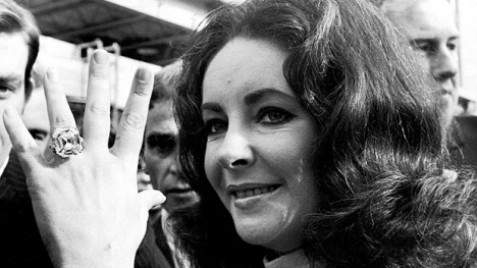
Elizabeth Taylor showing off the Krupp diamond ring, a piece of jewelry towards which she developed a strong personal attachment and became closely identified with her personality

Another photograph of Elizabeth Taylor wearing the Krupp diamond ring and diamond chandelier earrings
Another famous diamond, acquired by Burton, was the 69.42-carat, D-color, flawless, pear-shaped diamond, which he purchased from Cartier's in 1969, for a sum of $ 1,050,000. The diamond was mounted as a pendant on a platinum-diamond necklace by Cartier, and came to be known as the Taylor-Burton diamond.
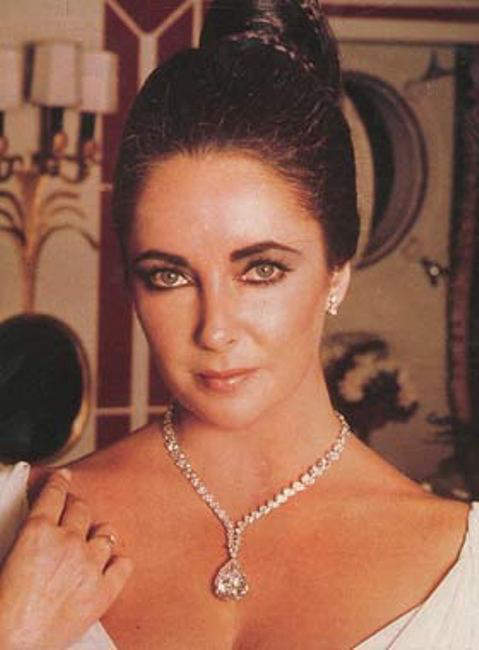
Elizabeth Taylor wearing a diamond necklace with the Taylor-Burton diamond as its pendant
The gift of the Taj Mahal diamond by Richard Burton to Elizabeth Taylor on her 40th birthday probably symbolized the true love and affection shown by Burton to his wife Liz Taylor
But, without any doubt the most outstanding gift that Taylor received from Burton for her 40th Birthday in 1972, was the 17th century Taj Mahal diamond which symbolizes the true love and affection shown by Burton to his wife Liz Taylor, just as much as, the same stone given as a gift by Emperor Shah Jahaan, to his beloved second wife Mumtaz Mahal in the 17th century symbolized the Emperor's true love and affection to his wife, who unfortunately died in childbirth in 1631. The internationally renowned Taj Mahal, that was built as a mausoleum for Mumtaz Mahal in 1631, immortalized their great relationship.

The Taj Mahal diamond with the Arabic inscription "Nur Jahan - Begum Badshah; 23; 1037"
© Christie's
But, unlike the tale of immortal love between Shah Jahaan and his beloved Mumtaz Mahal, the intense and passionate relationship between Burton and Taylor was unfortunately short lived and lasted only about 10 years. The couple divorced in 1974, but reconciled an year later and re-married in 1975. However the second marriage too broke up in 1976.
The Krupp diamond probably symbolized Elizabeth Taylor's undying love for Richard Burton as she developed a strong personal attachment to it and the ring became closely identified with her personality
Burton died in Switzerland in 1984, and it is said that up to this day Liz Taylor wears the 33.19-carat Krupp Diamond given to her by Burton as a symbol of his undying love for her. It appears that in spite of their separation, Liz Taylor's love for Richard Burton had not waned, and it is said that she has made plans for her ashes to be scattered in Burton's homeland of Wales upon her death and cremation.
Taylor has disposed of some of the jewels in her collection to raise funds for charitable purposes. In 1978, Elizabeth Taylor sold the Taylor-Burton diamond, and donated the proceeds to help build a hospital in Botswana, Africa. In the year 2002, she disposed of a diamond and emerald ring given by Burton, for US $ 80,000, and the proceeds were credited to Taylor's favorite Aids Charity.
"I have never thought of my jewelry as trophies" Taylor said, "I am just here to take care of them."
The Krupp diamond to which she has developed a strong personal attachment still remains in her hand in the platinum ring setting and is most likely to remain so until she breathes her last.
The up-coming sale of Elizabeth Taylor's jewelry collection, at Christie's New York on December 13-14, 2011
Elizabeth Taylor's jewelry collection, appropriately referred to as the "Crown Jewels of Hollywood" by a journalist, as she was the undisputed and uncrowned Queen of Hollywood until her death in March 2011, are due to be auctioned by Christie's New York, on December 13 & 14, 2011. Elizabeth Taylor's jewelry collection is considered as one of the greatest private collections ever assembled. A total of 269 magnificent jewels from this collection will be on offer during the two-day sale and is expected to realize over US$30 million. On the first day of the sale on December 13, 2011, at a special evening sale, Christie's will present 80 of Elizabeth Taylor's most iconic jewels, known as legendary jewels, and will include historic pieces such as the Krupp diamond, Taj Mahal diamond, and the La Peregrina pearl necklace. On December 14, 2011, during two day sale sessions, 189 additional jewels will also be put up for sale, making total of 269 jewels. Selected highlights from the collection were to be taken on a three-month global tour, prior to the sale, starting with a public exhibition on Moscow's Red Square on September 15, followed by exhibitions in London, Los Angeles, Dubai, Geneva, Paris and Hong Kong. The climax of the tour will be in December, prior to the sale, when the entire collection will be displayed at a special ten-day exhibition at Christie's New York.
A pre-sale estimate of US$ 2.5-3.5 million has been placed on the Krupp/Elizabeth Taylor diamond, but without any doubt the price realized for this legendary piece is expected to be at least double the upper pre-sale estimate.
The Krupp/Elizabeth Taylor diamond ring is Lot No. 80, the last lot of the Legendary Jewels, coming up for sale, at the special evening sale on December 13, 2011, at the New York Rockerfeller Plaza. A pre-sale estimate of US$ 2.5 million to 3.5 million has been placed on the legendary diamond ring. However, going by the credentials of the diamond, its top color, perfect cut, excellent clarity, and above all the historic provenance of the diamond, especially its ownership by the legendary actress, and the special attachment she developed towards the diamond, it is expected that the price realized for this iconic piece would be at least twice the upper pre-sale estimate or three times the lower estimate. This would be in keeping with the high prices recorded not only for colored diamonds, but also top color white diamonds at recent auctions held by renowned auction houses in Asia, the Middle East, Europe and America.
You are welcome to discuss this post/related topics with Dr Shihaan and other experts from around the world in our FORUMS (forums.internetstones.com)
Back to Famous Diamonds,Gemstones and Pearls
Related :-
3) Taj Mahal Diamond
References :-
1) Christie's Press Release - The Crown Jewels of Hollywood - The Collection of Elizabeth Taylor - September 7, 2011. www.christies.com
2) Christie's Sale 2623, The Collection of Elizabeth Taylor : Legendary Jewels, Evening Sale. Auction Catalogue. www.christies.com
3) A Byte Out of History - Krupp Diamond -The case of the disappearing diamond - www.fbi.gov
4) The Elizabeth Taylor Archives - Her Love Affair with Jewelry - www.dameelizabethtaylor.com
5) Krupp Diamond - From Wikipedia, the free encyclopedia
6) Richard Burton - From Wikipedia, the free encyclopedia
7) Elizabeth Taylor - From Wikipedia, the free encyclopedia.
8) Alfried Krupp von Bohlen und Halbach - From Wikipedia, the free encyclopedia.
Powered by Ultra Secure
Amazon (USA) Cloud Network

Founder Internet Stones.COM
Register in our Forums
| Featured In
|
|
|
|
|
|
|
|


















